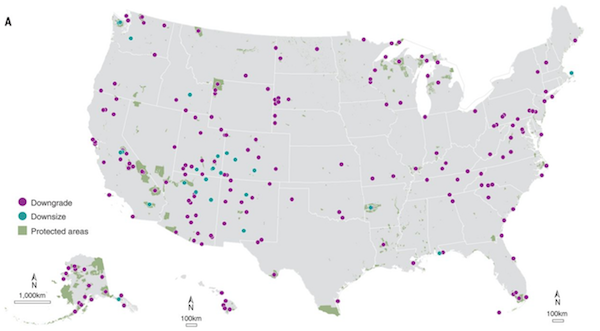
Changes in protected areas from 1892 to 2018. Image: Rachel E. Golden Kroner et al
Rollbacks on Protected Areas Sets a Dangerous Precedent
A protected area is a legally defined geographical space that’s actively managed to protect it in the long term from destructive human activities. These areas are crucial to the conservation of vulnerable species as well as the preservation of places of spiritual importance to indigenous people. However, a recent study published in Science Magazine shows that rollbacks of protected areas in the United States have vastly accelerated over recent decades.
Trump Compounds Historical Trends: From 1944 to 2017, 737 proposals for the downgrading, downsizing or complete stripping of all legal protection of protected areas took place within the United States, with a shocking 90% having occurred in the 2000’s alone. But under the Trump administration, two of the biggest rollbacks in the history of the United States took place in Utah in 2017.
- Created in 2016 by ex-President Barack Obama, President Trump signed a proclamation to shrink Bears Ears from 1.35 million acres to 201,876 acres.
- Grand Staircase-Escalante — created in 1996 by President Bill Clinton — was reduced from 1.9 million acres to 1 million.
Prioritizing Industry over Environment: This study found that 99% percent of the proposals for altering or eliminating protected areas were associated with industrial-scale development. After 114 failed proposals over 30 years, the Trump administration approved and established an oil and gas leasing program for the Coastal Plain of the Arctic National Wildlife Refuge (ANWR) in Alaska – overriding President Obama’s previous proclamation that declared the area as off-limits for drilling for environmental purposes.
Climate Mitigation and Adaption: Protected areas are crucial to mitigating and adapting to climate change. Over 312 gigatons of carbon – 15% of the global carbon stocks – is stored in protected areas. Protected mountain forests, coastal reefs and other ecosystems buffer human communities against disastrous events and provide a suite of services such as water and agricultural systems.
Why This Matters: The United States is home to the first modern protected areas—Yellowstone and Yosemite National Parks—and we’ve historically been a global conservation leader but with these trends of downscaling the fate of our public lands is in jeopardy. Debates on how our public lands should be managed date back to the time of President Teddy Roosevelt, but the Trump administration has taken the stance that their existence isn’t valuable beyond resource extraction.
Walking the Walk: A 2016 Harvard Kennedy School study revealed that more than 93% of respondents across the country said it’s important that historical sites, public lands, and national parks be protected for current and future generations. If that’s the case then we have to vote for candidates who support the protection (and even expansion) of public lands.
June 11, 2019 » conservation, protected areas, Public Lands, Trump


